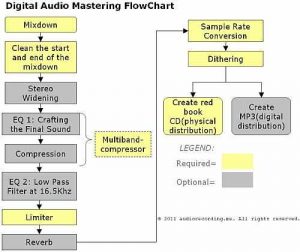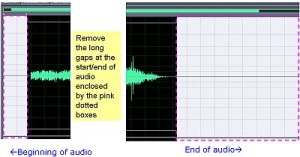Mastering is the last step in the music production process which will take place after audio mixing. Actually mastering is what makes your music radio friendly, broadcast ready or commercial polished sound. Without mastering, your music can hardly compete in the world of music business where sound recording “quality” is important. Mastering can improve your raw mix sound quality several times if the mastering process is done right. This tutorial is primary written to first time learners in audio mastering; those that prefer to learn on their own. This is my own technique acquired over years of experience. Other mastering engineers may have a similar or entirely different approach when mastering. This process works for me very well, so I am going to share this to you. To get started; examine the digital audio mastering process flowchart below:
The yellow boxes in the flow chart are important and required. The gray boxes are optional and only used when necessary. It is called “digital audio mastering” because everything is done inside a computer using mastering software. This tutorial will be using Adobe Audition, although the process is well applicable to other software as well with similar plug-in and effects. Everything will start on the mix down material. This is the product of the audio mixing process where the entire tracks are summed up into a single waveform known as the “mix down”. Technical format for mix down should be as high resolution as possible such as 24 bit/96Khz. I have written some guide on the detailed technical requirements of your audio mix down for mastering.
You will then launch your audio mastering software. The first thing that you will need to do is to clean the start and end of your mix down audio wave. Audio mix down introduces long silence/gaps at both start and end of the audio. You need to trim this within reasonable lengths. Screenshot:
After removing this gap, you can then optionally widen the stereo. This is only useful if you think the center of the stereo is too dominant in the mix. And the guitars which are panned hard on both left and right sound weak. By widening the stereo, those instruments panned in both left and right of the stereo field will become louder thus balancing with the dominant center. In Adobe Audition, you can implement this technique by going to Effects – Amplitude – Pan/Expand – Mastering Width preset. You will then use multi-band compressor to shape both the sound and dynamics of the audio. If you do not have a multi-band compressor, you can start with EQ to craft the final sound then compress after. Multi-band compressor allows you to compress and apply EQ at the same time, so it’s very useful to solve the following common audio mastering problems:
a.) The bass needs compression to accomplish the desired tightness/punch. If you apply only a specific compression setting affecting only the bass frequencies using a MB compressor, it won’t affect the dynamics of other bands (e.g. the mid and high frequencies).
b.) Maintain a good tonal balance overall while doing compression. It is because you can also adjust the gain of each band.
The following are the tutorials I have written pertaining to the use of MB compressor when mastering (using Waves plug-in):

